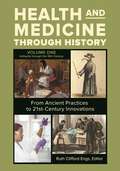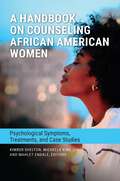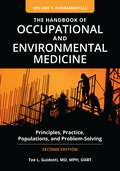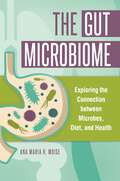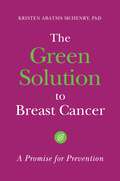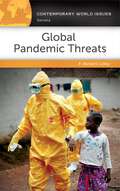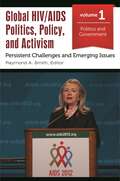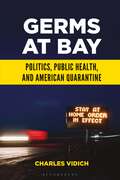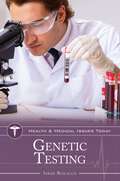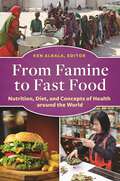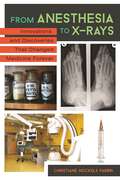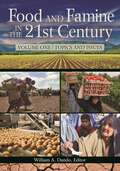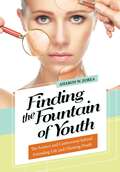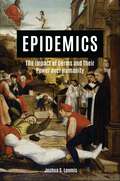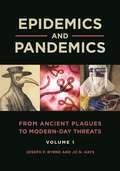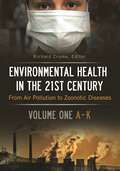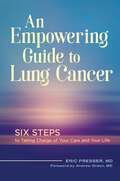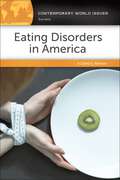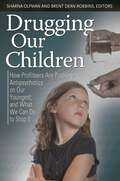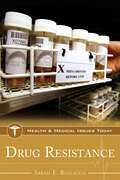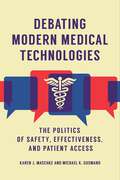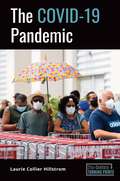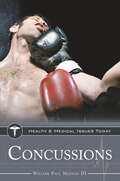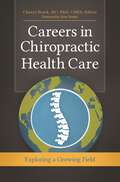- Table View
- List View
Health and Medicine through History [3 volumes]: From Ancient Practices to 21st-Century Innovations [3 volumes]
by Ruth Clifford EngsThis three-volume set provides a comprehensive yet concise global exploration of health and medicine from ancient times to the present day, helping readers to trace the development of concepts and practices around the world.From archaeological evidence of trepanning during prehistoric times to medieval Europe's conception of the four humors to present-day epidemics of diabetes and heart disease, health concerns and medical practices have changed considerably throughout the centuries. Health and Medicine through History: From Ancient Practices to 21st-Century Innovations is broken down into four distinct time periods: antiquity through the Middle Ages, the 15th through 18th centuries, the 19th century, and the 20th century and beyond. Each of these sections features the same 13-chapter structure, touching on a diverse array of topics such as women's health, medical institutions, common diseases, and representations of sickness and healing in the arts. Coverage is global, with the histories of the Americas, Europe, Asia, Africa, and Oceania compared and contrasted throughout. The book also features a large collection of primary sources, including document excerpts and statistical data. These resources offer readers valuable insights and foster analytical and critical thinking skills.
A Handbook on Counseling African American Women: Psychological Symptoms, Treatments, and Case Studies (Race and Ethnicity in Psychology)
by Kimber Shelton, Michelle King Lyn and Mahlet EndaleThrough an intersectional and inclusive lens, this book provides mental health professionals with a detailed overview of the mental health issues that Black women face as well as the best approach to culturally competent psychological practice with Black women.This text details mental health needs and treatment interventions for Black women. It provides a historical context of how the lived experiences of Black women contribute to mental wellness, identifies effective psychological practices in working with Black women, and challenges readers to advance their cultural competence while providing culturally affirming care to Black women. Additionally, this text is inclusive of sexual orientation and gender identity diversity, and it honors the diversity within Black women's identities, relationships, roles, and families.Written by an expert team of Black women clinicians, researchers, and medical professionals, A Handbook on Counseling African American Women: Psychological Symptoms, Treatments, and Case Studies addresses current sociopolitical events as well as historical trauma as it prepares readers to meet the needs of the Black women they serve.
The Handbook of Occupational and Environmental Medicine [2 volumes]: Principles, Practice, Populations, and Problem-Solving [2 volumes]
by Tee L. GuidottiProvides health professionals with a single, accessible, and interesting source to prepare for the field of occupational and environmental medicine. The new edition is extensively updated and includes questions for review in preparation for taking exams.This set is designed to be a thorough introduction for physicians entering the occupational and environmental medicine field, whether preparing for specialty examinations or moving into the field from other medical specialties or from primary care. It also serves as a convenient guide and reference for nurses, health professionals, and those outside of health care who need a quick orientation. The set is written with a strong and coherent point of view about the value of occupational and environmental medicine and commitment to ethical, worker-centered practice. It is unusual in the depth of its coverage; its inclusion of important topics that are usually overlooked in textbooks of the field, such as risk science; its emphasis on good management of occupational health services; and its thorough integration of material that fits topics together rather than presenting them as if they were separate and unrelated.
The Gut Microbiome: Exploring the Connection between Microbes, Diet, and Health
by Ana Maria MoiseThis accessibly written, comprehensive summary of research findings on the gut microbiome and its implications for health and disease—a topic of growing interest and concern—serves as an essential resource for teachers and students.Most people know that the digestive tract contains billions of helpful gut bacteria, but how does the gut microbiome affect our health? What exactly do these bacteria do, and what are the negative effects when these microorganisms are harmed by what we eat and do? What impacts might they have on conditions such as irritable bowel syndrome (IBS), obesity, and autism? This book provides an accessible, holistic introduction to the study of the human gut microbiome and its effects on digestion and disease—one of the newest and most rapidly expanding fields in medicine today.The gut microbiome is known as "the forgotten organ" because it is not identified as part of the human body per se, yet it has an immense influence on many systems in the body. The Gut Microbiome: Exploring the Connection between Microbes, Diet, and Health explains what the microbiome is, the many functions it serves, how it can be either harmed or supported by our actions, and the role it may play in various diseases and in determining our overall health. The book examines the various potential causes of imbalance in the microbiome, such as diet and other lifestyle factors, and then identifies strategies for improving human health by protecting the gut microbiota. The science-based information is detailed but accessible to general readers or students without extensive background knowledge.
The Green Solution to Breast Cancer: A Promise for Prevention
by Kristen Abatsis Ph.D.This unique, research-based investigation of the U.S. breast cancer movement compares the "pink" and "green" efforts within the movement and documents their use of similar citizen-science alliances, despite the contention over the use of consumer-based activism and pink products.Breast cancer activism is one of the most flourishing research and health advocacy movements in U.S. history. Yet the incidence of breast cancer is continuing to increase. This critical and revealing text investigates breast cancer activism in its two forms—the "pink movement" that focuses on developing awareness of, coping with, and managing breast cancer; and the "green movement" that strives to determine the possible environmental causes of breast cancer—such as pesticides, chemicals, and water and air pollution—and thereby hopes to prevent breast cancer.What caused this new green movement to develop? Will it replace or merge with the pink movement? Does either approach offer more promise for a solution? And how do the two movements differ in their positions or methodology towards a similar goal? With information culled from interviews with more than 50 industry stakeholders, The Green Solution to Breast Cancer: A Promise for Prevention argues that key attributes such as strategy, mission, and branding have led to a greater convergence between the pink and green wings of the movement and presents information that enables readers to consider if either approach might be the shorter route to beating breast cancer.
Global Pandemic Threats: A Reference Handbook (Contemporary World Issues)
by Michael C. LeMayThis book offers an accessible reference on epidemic and pandemic diseases that provides background information and history, explains why pandemics are a newly emerging threat, identifies the difficulties in coping with them, and provides hope in the form of modern medicine.Global Pandemic Threats: A Reference Handbook provides all-encompassing coverage that introduces key concepts and traces the history of pandemics, enabling readers to grasp the complexity of the global problem and the difficulties of executing effective solutions. Written in an easy-to-understand manner, it provides a "go-to" resource that systematically addresses dozens of diseases of the past as well as re-emergent or newly emerging pathogens that have the potential of becoming pandemics.The book's extensive coverage of past pandemics includes bubonic plague, cholera, influenza, measles, smallpox, tuberculosis, typhoid fever, and yellow fever, and the re-emergence of malaria, measles, pertussis (whooping cough), poliomyelitis, and other contagious diseases. It discusses a broad range of newly emerging viral threats, such as AIDS/HIV, avian flu, anthrax, botulism, Ebola, E. coli, Gulf War syndrome, hanta virus, Lassa virus, Lyme disease, Marburg virus, MERS, MRSA, Ricin, Sin Nombre virus (SNV), and West Nile virus. The work offers perspectives from individuals interested and involved in the fight, including medical professionals and health care workers; profiles of key organizations and persons; a helpful timeline of past and present pandemic outbreaks; and a glossary of key terms and concepts.
Global HIV/AIDS Politics, Policy, and Activism [3 volumes]: Persistent Challenges and Emerging Issues [3 volumes]
by Raymond A. SmithAn international team of specialists in politics, policy, and activism provide an indispensable guide to the persistent challenges and emerging issues posed by the global HIV/AIDS epidemic, now in its fourth decade.The HIV/AIDS epidemic is at a critical turning point. Compelling new findings herald the potential to eventually grind the epidemic to a halt through a combination of expanded treatment coverage and new biomedical approaches to prevention. At the same time, the severe global economic downturns have negatively affected wealthy donor nations that have provided the funds and technical support for programs in the developing world. It is against this backdrop that this landmark three-volume set was developed. It provides a broad overview of the critical political issues surrounding HIV/AIDS, inspects key areas of policy and policymaking, and spotlights the most important forms of activism and community mobilization.The volumes reflect an eclectic and wide-ranging set of issues written by an international team comprising dozens of authors from nations including the United States, the United Kingdom, Ghana, South Africa, Brazil, Cambodia, Norway, and Qatar. The international contributors represent a variety of disciplines and bring with them a range of styles and methodological approaches appropriate to their specific topics and disciplines. An important addition to academic and public libraries, this expansive work will benefit students and other readers interested in politics, policymaking, public health, activism, and community mobilization, both in the United States and globally.
Germs at Bay: Politics, Public Health, and American Quarantine
by Charles VidichThis book examines America's experience with a wide range of quarantine practices over the past 400 years and explores the political, economic, immigration, and public health considerations that have prompted success or failure within the evolving role of public health.The novel strain of coronavirus that emerged in late 2019 and became a worldwide pandemic in 2020 is only one of more than 87 new or emerging pathogens discovered since 1980 that have posed a risk to public health. While many may consider quarantine an antiquated practice, in reality it is often one of the only defenses against new and dangerous communicable diseases. Tracing the United States' quarantine practices through the colonial, postcolonial, and modern eras, Germs at Bay: Politics, Public Health, and American Quarantine provides an eye-opening look at how quarantine has worked despite routine dismissal of its value.This book is for anyone seeking to understand the challenges of controlling the spread of COVID-19 and will help readers internalize the lessons that may be learned from the pandemic. No other title provides this level of primary source data on the United States' long reliance on quarantine practices and the political, social, and economic factors that have influenced them.
Genetic Testing (Health and Medical Issues Today)
by Sarah BoslaughGenetic testing has provided important clues to understanding our health, but it has also raised many ethical, legal, and medical questions and concerns. This book explores the breadth of genetic testing, its possibilities, and the controversies that surround its use.The mapping of the human genome has paved the way for a variety of genetic tests. Expectant mothers can have their fetus screened for a variety of genetic abnormalities, and couples worried that they might be carriers for a genetic disorder can be tested before deciding to have children. Women can be screened for the BRCA2 gene that has been linked to increased risk of breast cancer. Individuals curious about their ancestry can find out more about their heritage. Genetic testing can also be used to establish paternity and help solve crimes.Part of Greenwood's Health and Medical Issues Today series, this book is divided into three sections. Part I explores the history of genetic testing, including the rise of direct-to-consumer tests, and outlines the current applications and contexts in which genetic testing is performed. Part II delves deep into the ethical, legal, financial, medical, and psychological issues and controversies that surround genetic testing. Part III provides a variety of useful materials, including case studies, a timeline of critical events, and a directory of resources.
From Famine to Fast Food: Nutrition, Diet, and Concepts of Health around the World
by Ken Albala Julia Abramson M. Shahrim Al-Karim E. N. Anderson Laura P. Appell-Warren Heather Arndt-Anderson Michael Ashkenazi Babette Audant Gabriela Villagran Backman Carolyn Bánfalvi Peter Barrett Cynthia D. Bertelsen Megan K. Blake Andrea Broomfield Cynthia Clampitt Neil L. Coletta Paul Crask Christine Crawford-Oppenheimer Anita Verna Liza Debevec Jonathan Deutsch Deborah Duchon Nathalie Dupree Pamela Elder Rachel Finn Richard Foss Nancy G. Freeman Ramin Ganeshram Hanna Garth Mary Gee Che Ann Abdul Ghani Maja Godina-Golija Annie Goldberg Darra Goldstein Keiko Goto Carla Guerrón Montero Mary Gunderson Liora Gvion Cherie Y. Hamilton Jessica B. Harris Melanie Haupt Ursula Heinzelmann Jennifer Hostetter Kelila Jaffe Zilkia Janer Brelyn Johnson Kate Johnston Desiree Koh Bruce Kraig R. J. Krajewski Erin Laverty Robert A. Leonard Jane Levi Yrsa Lindqvist William G. Lockwood Yvonne R. Lockwood Janet Long-Solís Kristina Lupp Máirtín Mac Con Iomaire Glenn R. Mack Andrea Macrae Giorgos Maltezakis Bertie Mandelblatt Marty Martindale Laura Mason Anton Masterovoy Anne Engammare Mcbride Michael R. Mcdonald Naomi M. Mcpherson Katrina Meynink Barbara J. Michael Diana Mincyte Rebecca Moore Nawal Nasrallah Henry Notaker Kelly O’ Leary Fabio Parasecoli Susan Ji-Young Park Rosemary Parkinson Charles Perry Irina Petrosian Suzanne Piscopo Theresa Preston-Werner Meg Ragland Carol Selva Rajah Birgit Ricquier Amy Riolo Owen Roberts Fiona Ross Signe Rousseau Kathleen Ryan Helen Saberi Cari Sánchez Peter Scholliers Colleen Taylor Roger Serunyigo Dorette Snover Celia Sorhaindo Lyra Spang Lois Stanford Aliza Stark Maria "Ging" Gutierrez Steinberg Anita Stewart Emily Stone Asele Surina Aylin Öney Tan Nicole Tarulevicz Karen Lau Taylor Thy Tran Leena Trivedi-Grenier Karin Vaneker Penny Van Esterik Richard Wilk Chelsie Yount Marcia ZoladzThe foods eaten by a nation's population play a key role in shaping the health of that society. This book presents country-specific information on how diet, food security, and concepts of health critically impact the well-being of the world's population.A country's food culture and eating habits directly impact the health and well-being of its citizens. Economic factors contribute to problems such as obesity and malnourishment. This book examines how diet affects health in countries around the world, discussing how the availability of food and the types of foods eaten influence numerous health factors and are tied to the prevalence of "lifestyle" diseases. Readers will discover the importance of diet and food culture in determining human health as well as make connections and notice larger trends within multicultural, international contexts.An ideal aid for high school and college students in completing research and writing assignments, this book supplies detailed diet- and health-related information about most major countries and regions in a single source. Each country profile will also include a convenient fact box with statistical information such as life expectancy, average caloric intake, and other health indicators.
From Anesthesia to X-Rays: Innovations and Discoveries That Changed Medicine Forever
by Christiane Nockels FabbriEasy to read and to use, this A-to-Z mini-encyclopedia covers the most important medical innovations of the last 200 years.Medical innovation is an extremely important topic—and one to which relatively little study has been devoted. This volume is designed to introduce readers to the history and development of key advances in the science and practice of medicine. It explores issues in medical history and provides perspective on contemporary scientific research and innovation. It also provides a backdrop against which to evaluate current headlines, such as the discoveries of live samples of smallpox virus in an unused storage room at the National Institutes of Health (NIH) and incidents of bubonic plague in China and Colorado.Although the entries in this single-volume resource describe how each innovation works, this is not intended as a technical text. Instead, the focus is on the context in which each innovation was developed and on its lasting importance in the field of medicine. Through these fascinating accounts, readers will be able to trace the evolution and legacy of key innovations and to see how other sectors of society—such as industry and the military—have affected and been affected by advances in the field of medicine.
Food and Famine in the 21st Century [2 volumes]: [2 volumes]
by Andrew D. Lohman Andrew Walter Ann Myatt James Bharath Ganesh-Babu Bimal Kanti Paul Carl Haub Christina E. Dando Christine Drake Danny M. Vaughn Dawn M. Drake Deborah Greenwood Dennis Skelton Donald J. Zeigler Frederick L. Bein Gregory Gaston John J. Hidore Joyce V. Cadwallader Kacey Mayes Kathleen Lamb Kozenski Kausar F. Siddiqi Kay Weller Melissa Martin Michael W. Kerwin Paul M. Chandler Paul Mausel Richard Snow Robin Leichenko Samuel T. Ledermann Sara A. Blackburn Stephen Aldrich Stephen J. Stadler Vijay Lulla Wiley C. Thompson William A. DandoThis comprehensive two-volume encyclopedia examines specific famines throughout history and contains entries on key topics related to food production, security and policies, and famine, giving readers an in-depth look at food crises and their causes, responses to them, and outcomes.Famines have claimed more lives across human history than all the wars ever fought.This two-volume set represents the most comprehensive study of food and famine currently available, providing the broadest analysis of hunger and famine causes as well as a detailed examination of the ramifications of cultural and natural hazards upon famine.Volume one focuses upon 50 topics and issues relating to the creation of hunger and famines in the world from 4000 BCE to 2100, including an overview of how agriculture has evolved from primitive hunting and gathering that supported limited numbers of people to a worldwide system that now feeds over seven billion people. Volume two, entitled Classic Famines, begins with famines of the past, from 4000 BCE to 2100 CE, includes ten classic famine case studies, and concludes with predictions of famines we could see in the 21st century and beyond.
Finding the Fountain of Youth: The Science and Controversy behind Extending Life and Cheating Death
by Aharon W. ZoreaSeparating truth from hype, this book introduces readers to the topic of life extension in a holistic manner that provides scientific, historical, and cultural perspectives.While the story of 16th-century explorer Juan Ponce de León futilely searching for the Fountain of Youth is likely a myth, it is true that for many centuries, mankind has sought "a cure for aging." Today, the anti-aging and longevity industry is a multibillion-dollar industry, and medical advances are continuing to find ways to add to our time on earth. Finding the Fountain of Youth: The Science and Controversy behind Extending Life and Cheating Death introduces readers to the topic of life extension in a holistic manner, examining the topic through scientific, historical, and cultural perspectives. It also highlights key medical and ethical controversies related to this particular area of gerontology and serves as a gateway for further research and study.The book's chapters address the history of movements to remain youthful, from ancient times through the modern era; past medical advances that significantly extended the average lifespan; and our cultural obsession with "staying young" that has spawned the anti-aging industry. Readers will learn about basic principles of aging and anti-aging, as well as the science behind the methods—both proven and hypothetical—that serve to extend the lifespan. The final section of the book examines controversial issues and debates related to life extension, such as global overpopulation, length of life versus quality of life, and socioeconomic concerns.
Essential Oils: Your Questions Answered (Q&A Health Guides)
by Randi MinetorThis book provides easy-to-understand, scientifically backed answers to readers' questions about essential oils, helping them make informed decisions about which products to use and how and setting realistic expectations about what essential oils can and cannot do to improve well-being.Many people use essential oils regularly yet know very little about them. What exactly makes them "essential"? Can they really be used to treat ailments like infections, fevers, and sore throats? Is it safe to ingest them or use them around children and pets? How can you tell if a company selling essential oils is offering a low-quality product or engaging in shady business practices? This book answers these and many more questions about these popular yet often poorly understood products.Books in Greenwood's Q&A Health Guides series follow a reader-friendly question-and-answer format that anticipates readers' needs and concerns. Prevalent myths and misconceptions are identified and dispelled, and a collection of case studies illustrate key concepts and issues through relatable stories and insightful recommendations. Each book also includes a section on health literacy, equipping teens and young adults with practical tools and strategies for finding, evaluating, and using credible sources of health information both on and off the internet—important skills that contribute to a lifetime of healthy decision-making.
Epidemics: The Impact of Germs and Their Power over Humanity
by Joshua S. LoomisThis book comprehensively reviews the 10 most influential epidemics in history, going beyond morbid accounts of symptoms and statistics to tell the often forgotten stories of what made these epidemics so calamitous.Unlike other books on epidemics, which either focus on the science behind how microbes cause disease or tell first-person accounts of one particular disease, Epidemics: The Impact of Germs and Their Power over Humanity takes a holistic approach to explaining how these diseases have shaped who we are as a society. Each of the worst epidemic diseases is discussed from the perspective of how it has been a causative agent of change with respect to our history, religious traditions, social interactions, and technology. In looking at world history through the lens of epidemic diseases, readers will come to appreciate how much we owe to the oldest and smallest parasites. Adults and students interested in science and history—and especially anyone who appreciates a good story and has a healthy curiosity for the lesser-known facts of life—will find this book of interest. Health-care workers will also benefit greatly from this text, as will college students majoring in biology or a pre-health field.
Epidemics and Pandemics [2 volumes]: From Ancient Plagues to Modern-Day Threats [2 volumes]
by Joseph P. Byrne Jo N. HaysBeyond their impact on public health, epidemics shape and are shaped by political, economic, and social forces. This book examines these connections, exploring key topics in the study of disease outbreaks and delving deep into specific historical and contemporary examples.From the Black Death that ravaged Europe in the 14th century to the influenza pandemic following World War I and the novel strain of coronavirus that made "social distancing" the new normal, wide-scale disease outbreaks have played an important role throughout human history. In addition to the toll they take on human lives, epidemics have spurred medical innovations, toppled governments, crippled economies, and led to cultural revolutions.Epidemics and Pandemics: From Ancient Plagues to Modern-Day Threats provides readers with a holistic view of the terrifying—and fascinating—topic of epidemics and pandemics. In Volume 1, readers will discover what an epidemic is, how it emerges and spreads, what diseases are most likely to become epidemics, and how disease outbreaks are tracked, prevented, and combatted. They will learn about the impacts of such modern factors as global air travel and antibiotic resistance, as well as the roles played by public health agencies and the media. Volume 2 offers detailed case studies that explore the course and lasting significance of individual epidemics and pandemics throughout history.
Environmental Health in the 21st Century [2 volumes]: From Air Pollution to Zoonotic Diseases [2 volumes]
by Richard CrumeThis concisely written and easy-to-read resource provides information on emerging issues and valuable historical context that enables students to better understand a broad range of environmental health topics, from pollution to infectious diseases, natural disasters, and waste management.As technology enables better insight into the world we live in, we are increasingly aware of environmental health concerns and risks, from contaminated air and water to infectious diseases and light and noise pollution. Because the quality of our lives depends on the quality of our environment, everyone should be informed about issues in environmental health. Environmental Health in the 21st Century: From Air Pollution to Zoonotic Diseases presents hundreds of encyclopedic entries written by expert researchers and practitioners, a history of environmental health, and interviews with subject experts that broadly survey the field of environmental health. The set covers myriad subjects in environmental health, including all types of environmental pollution; the spread of communicable diseases and other issues in the health sciences; waste management practices; the effects of climate change on human health; children's environmental health concerns; environmental health problems unique to the urban environment; and emerging threats such as the Zika virus and hospital-acquired infections. Readers will learn about steps they can take to reduce their environmental risk, understand the effects of key international treaties and conventions and the contributions of key figures in environmental health, and also reflect on potential solutions for global challenges in environmental pollution, health sciences, energy and climate, waste management, and the built environment. No other book on the market today addresses the environmental health field in such a comprehensive manner, with the latest information provided by expert practitioners, all packed into two concise volumes.
An Empowering Guide to Lung Cancer: Six Steps to Taking Charge of Your Care and Your Life
by Eric Presser MDDispelling the commonly held belief that lung cancer is always self-inflicted, this book guides patients, their loved ones, and caregivers through diagnosis, acceptance, and treatment, and provides support and hope to the tens of thousands of people coping with this illness.Lung cancer is a serious illness—one that is considered among medicine's most dreaded diagnoses. Alone, it's responsible for 29 percent of cancer deaths in the United States and causes more deaths than breast, colon, ovarian, and prostate cancer combined! Additionally, lung cancer isn't typically discovered until it causes symptoms, at which point options are limited and the chances of a cure greatly reduced. But it doesn't have to be this way. In this book, Dr. Eric Presser provides an empowering, comprehensive guide to lung cancer for anyone seeking a deeper understanding of the treatments available, coping with the diagnosis, and dealing with the side effects associated with the disease on both patients and their loved ones. His book offers a complete resource for anyone touched by lung cancer, presenting the latest scientifically tested information to help reduce the rates of illness and infirmity and ultimately make lung cancer a thing of the past. The book first covers the basic information necessary to understand lung cancer, including lung anatomy. Dr. Presser then identifies the six steps that will with help people cope with lung cancer and take charge of their lives. The final section focuses on nutrition and lung cancer in addition to practical concerns such as health insurance, work and disability, and financial challenges.
Eating Disorders in America: A Reference Handbook (Contemporary World Issues)
by David E. NewtonAn indispensable resource for readers interested in eating disorders, this book summarizes their history in human civilization, assesses the current status of eating disorders in American society, and describes efforts for establishing effective prevention and treatment programs.Although eating disorders have existed for centuries, considerable controversy remains as to the basic cause or causes of these disorders and their genetic, biological, and/or psychological factors. Eating Disorders in America: A Reference Handbook investigates these disorders, priming readers on the causes, symptoms, controversies, and treatments available. The two opening chapters of the book provide general background and a historical review of the existence of eating disorders in society. The remaining chapters provide resources the reader can use for further research, such as an extensive annotated bibliography, a glossary, and a chronology. This book differs from others on the topic in that it provides both an expository section that provides information as well as a set of resources for further research. The book also contains a "perspectives" chapter in which writers describe and discuss their personal views on the subject of eating disorders. Together with the author's expertise, these views add to the value of this book as a resource for eating disorder research.
Drugging Our Children: How Profiteers Are Pushing Antipsychotics on Our Youngest, and What We Can Do to Stop It (Childhood in America)
by Sharna Olfman Brent Dean Robbins Laura E. Berk Barry L. Duncan Jim Gottstein Adena B. Meyers Gwen Olsen Stuart Shanker Jacqueline A. Sparks Tony Stanton George Stone Robert WhitakerThis book exposes the skyrocketing rate of antipsychotic drug prescriptions for children, identifies grave dangers when children's mental health care is driven by market forces, describes effective therapeutic care for children typically prescribed antipsychotics, and explains how to navigate a drug-fueled mental health system.Since 2001, there has been a dramatic increase in the use of antipsychotics to treat children for an ever-expanding list of symptoms. The prescription rate for toddlers, preschoolers, and middle-class children has doubled, while the prescribing rate for low-income children covered by Medicaid has quadrupled. In a majority of cases, these drugs are neither FDA-approved nor justified by research for the children's conditions.This book examines the reasons behind the explosion of antipsychotic drug prescriptions for children, spotlighting the historical and cultural factors as well as the role of the pharmaceutical industry in this trend; and discusses the ethical and legal responsibilities and ramifications for non-MDs—psychologists in particular—who work with children treated with antipsychotics.Contributors explain how the pharmaceutical industry has inserted itself into every step of medical education, rendering objectivity in the scientific understanding, use, and approvals of such drugs impossible. The text describes the relentless marketing behind the drug sales, even going as far as to provide coloring and picture books for children related to the drug at issue. Valuable information about legal recourse that families and therapists can take when their children or patients have been harmed by antipsychotic drugs and alternative approaches to working with children with emotional and behavioral challenges is also provided.
Drug Resistance (Health and Medical Issues Today)
by Sarah BoslaughWritten in clear, nontechnical language, this investigation of drug resistance provides readers with an overview of the scientific issues, the current scope of the problem nationally and globally, and the measures that can be taken to combat this public health crisis.Drug resistance—the reduction in the effectiveness of a particular medicine (particularly antimicrobials) in treating a disease or condition—is considered one of the most pressing issues in medicine today. This problem is likely to have profound impacts on society in the decades to come. This understandable, single-volume book explores the history of drug resistance, explains how drug resistance occurs, cites the most problematic examples, identifies the potential consequences, and describes how drug resistance can be prevented. It also pays attention to current issues and controversies surrounding this topic, such as the role of the industrialized food system in breeding antibiotic-resistant strains of E. coli.The coverage includes up-to-date information about specific diseases like tuberculosis, malaria, human immunodeficiency virus (HIV), and methicillin-resistant Staphylococcus aureus (MRSA), for which drug resistance is a particular issue. Readers will understand how human behavior, such as patient non-adherence to treatment and physician over-prescription of antibiotics, have served to foster drug resistance. A selection of primary documents sourced from organizations such as the World Health Organization, the U.S. Food and Drug Administration, and the Centers for Disease Control and Prevention will serve those interested in pursuing more detailed research on particular topics.
Debating Modern Medical Technologies: The Politics of Safety, Effectiveness, and Patient Access
by Karen J. Maschke Michael K. GusmanoThis book analyzes policy fights about what counts as good evidence of safety and effectiveness when it comes to new health care technologies in the United States and what political decisions mean for patients and doctors.Medical technologies often promise to extend and improve quality of life but come with many questions: Are they safe and effective? Are they worth the cost? When should they be allowed on the market, and when should Medicare, Medicaid, and private insurance companies be required to pay for drugs, devices, and diagnostic tests? Using case studies of disputes about the value of mammography screening; genetic testing for disease risk; brain imaging technologies to detect biomarkers associated with Alzheimer's disease; cell-based therapies; and new, expensive drugs, Maschke and Gusmano illustrate how scientific disagreements about what counts as good evidence of safety and effectiveness are often swept up in partisan fights over health care reform and battles among insurance and health care companies, physicians, and patient advocates. Debating Modern Medical Technologies: The Politics of Safety, Effectiveness, and Patient Access reveals stakeholders' differing values and interests regarding patient choice, physician autonomy, risk assessment, government intervention in medicine and technology assessment, and scientific innovation as a driver of national and global economies. It will help readers to understand the nature and complexity of past and current policy disagreements and their effects on patients.
The COVID-19 Pandemic (21st-Century Turning Points)
by Laurie Collier HillstromThis authoritative work provides a thorough overview of the COVID-19 pandemic that swept the globe in 2020, devoting particular attention to its impact on all aspects of American society.The 21st Century Turning Points series is a one-stop resource for understanding the people and events changing America today. Each volume provides readers with a clear, authoritative, and unbiased understanding of a single issue or event that is driving national debate about our nation's leaders, institutions, values, and priorities.This particular volume is devoted to the deadly COVID-19 pandemic that disrupted social, economic, and political institutions across the globe in 2020. It documents the spread of the virus around the world and the mounting toll it took on the health and lives of people in the United States and elsewhere; surveys the response to the pandemic (both in statements and policies) by the Trump administration, state governments, and various scientific and public health organizations; explains the impact of the pandemic on U.S. schools, businesses, industries, and workers; shows why communities of color and poor Americans were disproportionately impacted; and studies the ways in which COVID-19 has changed the U.S. forever.
Concussions (Health and Medical Issues Today)
by William Paul IIIThis book provides a broad introduction to the important topic of concussive brain injury that considers historical, medical, research-based, and legal and ethical perspectives.The devastating long-term effects of concussions and the apparent mismanagement of concussion treatment among college and professional athletes have received major media attention in recent years. Do athletes—especially young ones—and their parents understand the physical risks and potential lifelong costs involved with playing their sport? Are injuries handled properly, or are players' careers and teams' successes put ahead of health and safety? Written by a Harvard-educated doctor who conducts clinical and scientific research in the area of sports injuries and concussive brain injuries, this book provides readers with honest and authoritative information about concussions. The book's chapters address the subject from all angles and shed light on current debates related to concussions caused by sports injuries and accidents.
Careers in Chiropractic Health Care: Exploring a Growing Field
by Cheryl Hawk and John WeeksThis book provides potential students of a chiropractic career path, as well as other health care practitioners, with vital information regarding the training required to enter the chiropractic field and the roles of chiropractors in modern health care.Chiropractic is the second largest physician-level health profession in the United States, with chiropractors providing care to at least 20 million patients annually. As chiropractic health care has been proven to be both effective and cost effective for many musculoskeletal conditions, particularly back pain, the inclusion of Doctors of Chiropractic (DCs) in a variety of health care settings is likely to continue to increase. Surprisingly, there is little readily accessible information on chiropractic as a career path. This book provides concise yet comprehensive information about career paths, training, and professional roles in chiropractic for students considering chiropractic as well as health care practitioners in the field.Written in an easy-to-read style, Careers in Chiropractic Health Care: Exploring a Growing Field serves students, those in non-chiropractic health fields, and general readers considering chiropractic as a career change option. The chapters explain the training and specific licensure requirements for chiropractors in all 50 U.S. states and provide information useful to health care professionals for referrals and management of patients using chiropractic care.
